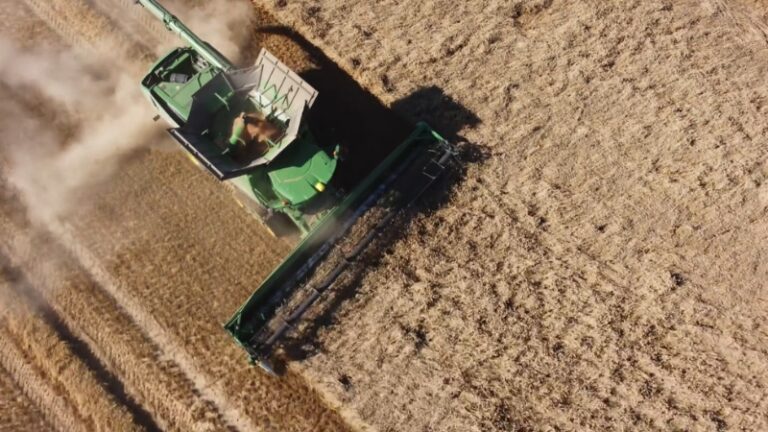When you spread butter on your toast or take that first bite of your morning bagel, it’s easy to forget where that food comes from.
Behind every loaf of bread, plate of pasta, or breakfast pastry is a long chain of effort that starts in the fields, often right here in Alberta.
Wheat is one of the province’s most important crops, and the harvest season is the culmination of months of preparation, labor, and risk-taking by farmers.
While we often think of farming as something that happens “out there,” far away from city life, the truth is that Alberta’s wheat farmers are closely connected to the food on your plate.
They work in unpredictable conditions, often from early morning to late at night, ensuring the wheat harvest is done efficiently and on time.
1. Wheat Seeding and Harvest Timing Varies Widely—Even Within Alberta
View this post on Instagram
In Alberta, the timing of wheat planting and harvest isn’t uniform across the province. Climate and geography play a significant role in when seeding begins and when the fields are ready to harvest.
Wheat typically takes around 90 to 100 days to grow from seed to full maturity, but the exact timing depends on when farmers are able to get their crops into the ground.
In southern and central Alberta, where the spring weather warms earlier, farmers often begin seeding their wheat in April.
These fields usually reach harvest stage by mid to late August.
But travel further north in the province, and you’ll find farmers working on a slightly delayed schedule. In cooler northern regions, seeding may not happen until May, with harvest extending into early September.
This variation in timing allows Alberta farmers to maximize productivity across regions, but it also requires careful planning.
Each farmer must make decisions based on their local soil conditions, weather forecasts, and equipment availability.
Timing is everything: too early and a late frost could kill off young plants; too late and there’s a risk of running into early snow before the crop can be harvested.
2. Weather Can Make or Break a Wheat Harvest
How it starts and how it’s going. never seen a wheat crop go backwards so fast. With three weeks of record-setting temperatures with no rain. Hottest June in recorded history in Edmonton area. July of to a hot start. pic.twitter.com/K0cPQBazZq
— Reden Farms (@redenfarms) July 13, 2021
If there’s one thing farmers watch constantly, it’s the weather. In Alberta, where weather conditions can change dramatically and without much notice, it can have a huge impact on both the timing and the success of a wheat harvest.
Everything from spring rainfall to summer droughts and autumn frost can affect how well the wheat grows and when it’s ready to be harvested.
Moisture content in the wheat kernel is especially critical. Harvesting too early—when the kernels are still too moist—can lead to spoiled grain that can’t be stored or sold.
Conversely, waiting too long can expose the crop to weather damage like heavy rains, windstorms, or even snow. In years with heavy rainfall, fields can become too wet to support heavy harvesting equipment, which can delay the process and lead to crop losses.
Dry conditions can be just as problematic.
Drought limits wheat’s growth, often resulting in shorter plants and fewer grains per stalk.
That means lower yields and reduced income for the farmer.
Many parts of Alberta have faced serious droughts in recent years, leaving farmers with hard decisions about whether to invest in inputs like fertilizer or accept that yields will be below average.
In years with particularly harsh conditions, farmers may also need to use additional equipment like grain dryers, which reduce the moisture level in harvested wheat before it can be stored.
These dryers are expensive to run, requiring both fuel and time, which adds another layer of cost and stress to the process.
3. The Combine Harvester: The Machine That Brings in the Crop
If you’ve ever driven past wheat fields in late summer or early fall, you’ve probably seen a combine harvester at work.
These massive machines are designed specifically for the complex job of collecting grain from mature plants.
Wheat secrets, like how different conditions affect the grain’s quality, are crucial for farmers to know to maximize their harvest.
Harvesting wheat is not just a matter of cutting down the stalks—it’s a multi-step process that separates the edible grain from the inedible parts of the plant.
Combines do this with remarkable efficiency. As they move across the field, rotating blades at the front cut the wheat stalks.
Inside the machine, the wheat heads are threshed to separate the grain kernels from the husk and chaff.
The grain is then cleaned using a series of sieves and elevators before being stored temporarily in the machine’s grain tank.
Once the combine’s tank is full, an auger moves the grain into a grain cart or truck that drives alongside the combine.
This process allows harvesting to continue without interruption.
Meanwhile, the leftover plant material—the straw and chaff—is chopped and spread across the field, where it decomposes naturally and can help enrich the soil for future crops.
Modern combines are equipped with GPS systems, moisture sensors, and yield monitors, all of which help farmers manage their crops more precisely.
However, even with all this technology, the process still requires a skilled operator who understands the field conditions and the machine’s capabilities.
4. Harvest Is a Long, Intense Process—Not a One-Day Job
-

Source: Youtube/Screenshot, Delays can lead to major financial losses if the crop is damaged before storage
Wheat harvest in Alberta is anything but quick. Most wheat farms span hundreds or even thousands of acres. Harvesting that much land takes time, especially when you factor in the unpredictability of weather, mechanical breakdowns, and the limited hours of daylight in late summer.
During harvest season, farmers often work from sunrise until well after dark. It’s not uncommon for farm families to work 14- to 16-hour days for weeks on end to get their crops off the field in time.
The pressure is high—delays can mean significant financial losses if the crop gets damaged before it can be stored.
In addition to running combines and grain trucks, many farmers are simultaneously managing storage logistics, checking moisture levels, monitoring the weather forecast, and coordinating with local grain buyers or elevators.
Every step has to line up so that the grain gets safely from the field to the bin, and eventually to the processor who turns it into food.
And even once the wheat is harvested, the job isn’t finished. Equipment has to be cleaned and maintained, bins need to be monitored for temperature and moisture, and in some cases, drying and transport arrangements have to be made.
Harvest season might be the most visible part of a farmer’s year, but it’s just one phase in a 12-month cycle of planning, planting, growing, and managing.
Bottom Line
@agricultureforlife Did you know that we grow two types of wheat in Alberta? Spring wheat and winter wheat! In Alberta, producers grow both varieties in order to maximize their yield. These two types of wheat are also used for different purposes—winter wheat has more protein in it and is used to produce bread or pasta while spring wheat is generally used for products like desserts or pastries. Agriculture is engrained in our everyday lives—but how much do we really know? Ag 101 is bringing fun agriculture facts to you! Follow Agriculture for Life and Viterra for more Ag 101 shorts and to learn more about Alberta agriculture. For more agriculture educational resources, visit agricultureforlife.ca. #wheat #winterwheat #springwheat #crop #producers #farmers #flour #pasta #bread #farm #farmtofork #growlocal #eatlocalgrown #abfood #agfunfacts ♬ original sound – Agriculture For Life
Wheat is a staple crop in Alberta and one of Canada’s most significant agricultural exports. What happens in the fields each summer directly affects food supply chains, grocery prices, and global food markets.
The next time you eat a sandwich, bake cookies, or open a box of pasta, there’s a good chance some of that wheat started in an Alberta field.
Understanding the complexity behind wheat farming helps us appreciate the work that goes into something as simple as a loaf of bread.
From monitoring weather patterns to operating heavy machinery and managing the risks of an unpredictable harvest window, Alberta’s wheat farmers take on a tremendous responsibility to feed not just their province, but the world.

